Life and work of Eric Zepler - the early years
The words in this section are care of Greville Bloodworth
Four Crucial Words
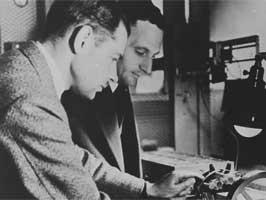 Erich Ernst Zepler was born in Germany in 1898, and moved to England in 1935, anglicising his name to Eric Ernest Zepler. Before writing about his life and work I want to quote four crucial words that he spoke in 1925, when he was being interviewed for an appointment at Telefunken in Berlin by Wilhelm Runge, the new Head of the Radio Receiver Laboratory.
Erich Ernst Zepler was born in Germany in 1898, and moved to England in 1935, anglicising his name to Eric Ernest Zepler. Before writing about his life and work I want to quote four crucial words that he spoke in 1925, when he was being interviewed for an appointment at Telefunken in Berlin by Wilhelm Runge, the new Head of the Radio Receiver Laboratory.
Runge described a high frequency problem in a new receiver that was being designed. Previously such problems had been solved largely by trial and error. Erich Zepler said “that can be calculated” and showed how he would do it. He got the job.
Those two men, with Ernst Klotz, had led a revolution in receiver design between 1925 and 1932, which had included the development of the Telefunken T9W receiver. The School of Electronics and Computer Science has one of those receivers, in working order.
From being a black art of trial and error, radio design was becoming an engineering discipline where the performance of new equipment could be determined before it was constructed. As electronic engineers we can take that situation for granted today, because of the achievements of engineers like Runge, Zepler and Klotz.
Eric Zepler was not only a great pioneering radio designer. In England he became a great teacher. After the experience of being his students or his colleagues many of us have dealt with engineering design problems by saying to ourselves, consciously or subconsciously, “that can be calculated”.
1898-1909 Childhood
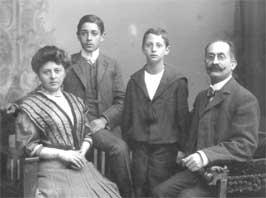 "Erich Ernst Zepler was born on 27 January 1898 in Herford, a small town in Westphalia in Germany. He was the younger son of Martin Zepler, a country doctor, and his wife Flora. Martin tended his patients by the light of oil lamps, and made his visits on foot.
"Erich Ernst Zepler was born on 27 January 1898 in Herford, a small town in Westphalia in Germany. He was the younger son of Martin Zepler, a country doctor, and his wife Flora. Martin tended his patients by the light of oil lamps, and made his visits on foot.
In 1902 Martin and Flora converted from Judaism to Christianity and Erich was baptised. The family moved to Evingsen in Westphalia before Erich started going to primary school.
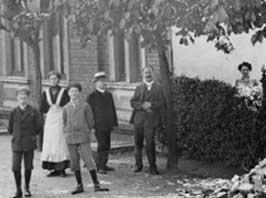
Erich started to play chess while he was at primary school, and was composing chess problems at the age of fourteen while he was at grammar school.This activity gave an early indication of his exceptional analytical ability. Throughout his life he had a passion for chess, especially for the composition of chess problems.
1909-16 Grammar School
Eric Zepler attended the Realgymnasium (a grammar school) in Altena, in Westphalia. He began his university studies in 1916, at Bonn University.
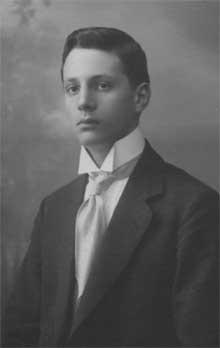
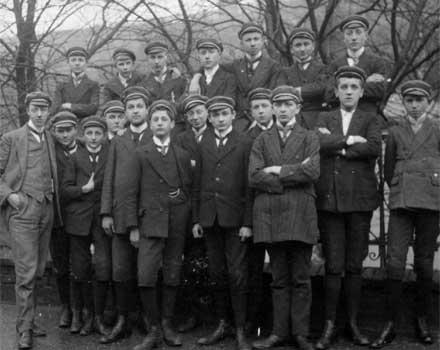
1916-23 University studies
Although Erich Zepler was enlisted for service in the German Army during the First World War, ill-health prevented him from being sent to a battlefield. Instead, he was able to study physics at the Universities of Bonn (1916-18) and Berlin (1919-20).
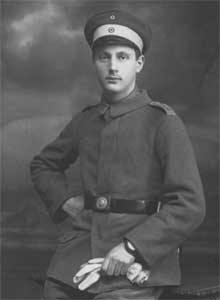
After graduating from Berlin University Erich Zepler undertook research work at the University of Würzburg,and was awarded the DPhil degree in 1922. He continued research at the Würzburg Institute of Physics until 1923, when he left to participate in pioneering industrial work on radio engineering at the start of the radio boom.
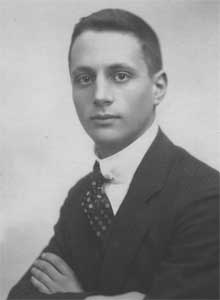
1927-28 Telefunken T9W receiver linked to T9W receiver circuit
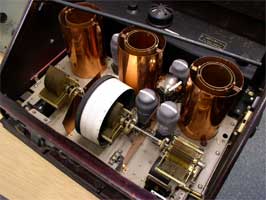 The T9W receiver, designed by Erich Zepler and Ernst Klotz in 1927/8, was the first “all mains” broadcast-receiver marketed by Telefunken. An example owned by Electronics and Computer Science, in working order, was transferred to Southampton from the Technical Institute of Bochum in Germany after Eric Zepler’s death in 1980.
The T9W receiver, designed by Erich Zepler and Ernst Klotz in 1927/8, was the first “all mains” broadcast-receiver marketed by Telefunken. An example owned by Electronics and Computer Science, in working order, was transferred to Southampton from the Technical Institute of Bochum in Germany after Eric Zepler’s death in 1980.
Copper cylinders provided screening for the transformer coils. In the construction of this receiver the workmanship was of high quality. However, the external appearance lacked styling. Seemingly Telefunken regarded its receivers as industrial equipment rather than pieces of domestic furniture. This receiver was put on sale at a price of 755 reichmarks, which would have been expensive for furniture. For comparison, when the Nazi regime came to power it ordered the production of a People’s Receiver that would sell at a subsidised price of 35 reichmarks. That was roughly equal to the average weekly wage at the time.
The first four stages, using REN1104 triode valves, comprised two neutralised RF stages, a grid detector and an audio amplifier. The power output stage used a RE134 triode valve. The aerial was coupled to the first RF stage by a variable capacitor. Switching between coils in parallel was used to select the waveband (200-400, 350-700 or 600-2000 metres). Feedback from a tapping on the grid coil of the next stage was used for neutralisation. The gain of the RF stages was controlled by a rheostat in the HT feeds. The three tuning capacitors were ganged. The leaky-grid detector was transformer coupled to the first AF stage. Grid bias for all of the valves except the detector was derived from a potential divider between HT- and the chassis. An external loudspeaker was used.
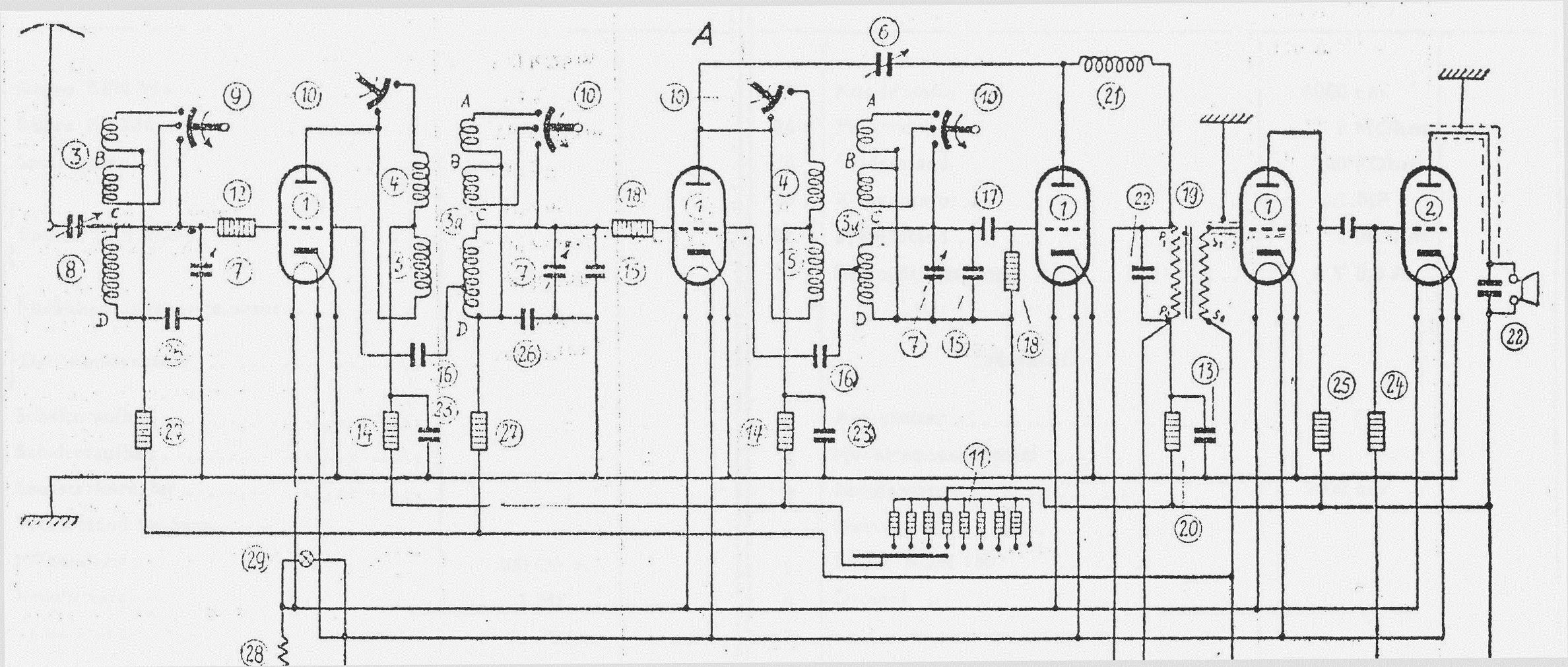
1932-35 Head of receiver design
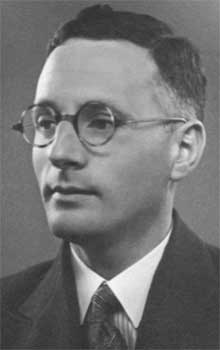 In 1932, during the economic depression, the radio receiver laboratories of AEG and Siemens were incorporated into Telefunken. Erich Zepler became the Head of Design for Receivers and Direction Finders, with responsibility for commercial and military equipment. Also, some small transmitters were designed. His department developed equipment for the state-owned broadcasting organisation, and for marine communications. An example of its work for the military sector was the FuG III transceiver used by the Luftwaffe.
In 1932, during the economic depression, the radio receiver laboratories of AEG and Siemens were incorporated into Telefunken. Erich Zepler became the Head of Design for Receivers and Direction Finders, with responsibility for commercial and military equipment. Also, some small transmitters were designed. His department developed equipment for the state-owned broadcasting organisation, and for marine communications. An example of its work for the military sector was the FuG III transceiver used by the Luftwaffe.
Erich Zepler published articles on a wide range of subjects, many of them in Telefunken-Zeitung. Selected at random, some of these subjects were antenna coupling, feedback HF amplifiers, airborne and shipborne direction-finding equipment, and radio equipment for aircraft and for the steamship “Bremen”.
When he left Telefunken at the end of 1935 he had 37 individual patents and 22 joint patents to his name. Again selected at random, there were Zepler patents on “Selection of coupling”, “Drum switch”, “Grid input negative feedback”, “Smooth feedback operation” and “Direction finding equipment with inductive tuning”. Clearly he was an exceptionally inventive engineer, who stimulated the technical work of his large department by a stream of novel ideas, and had the energy to pursue many diverse projects.
1936-39 Design Work at Marconi
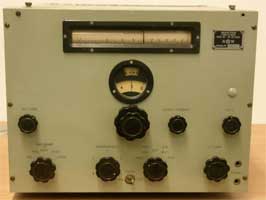 Erich Zepler had married Eleonore Fischer in 1926. In December 1935 he left Germany because of the rising intensity of racial persecution by the Nazi government, and moved to England. His wife and children followed soon afterwards. Unfortunately his parents were not allowed to move to England, and his father died in 1939. Tragically, his mother became a victim of the Holocaust in 1943. In England he anglicised his name to Eric Ernest Zepler, and his wife and children were called Lore, Carole and Matthew. His family would become naturalised British subjects in 1947.
Erich Zepler had married Eleonore Fischer in 1926. In December 1935 he left Germany because of the rising intensity of racial persecution by the Nazi government, and moved to England. His wife and children followed soon afterwards. Unfortunately his parents were not allowed to move to England, and his father died in 1939. Tragically, his mother became a victim of the Holocaust in 1943. In England he anglicised his name to Eric Ernest Zepler, and his wife and children were called Lore, Carole and Matthew. His family would become naturalised British subjects in 1947.
Before leaving Germany, Zepler arranged to join the Marconi Wireless Telegraph Company in Chelmsford, where he resumed his design work on radio receivers and transmitters, and worked hard to master the English language. He became responsible for the design of the Marconi CR100 superhet receiver, which would become the standard MF/HF receiver on Royal Navy ships during the Second World War. It used 11 thermionic valves altogether, including 2 RF and 3 IF stages. Crystal filters were coming into use, for example in the B28/CR100 receiver. This was made in 1939, and operates over the frequency range 60 kHz – 30 MHz in 6 bands. The upper tuning dial gives a linear reading of frequency, and rotates when the band switch is operated.
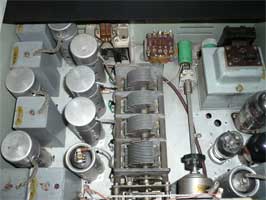 The Marconi superhet transmitter-receivers 1154 and 1155, which were widely used in RAF aircraft during the war, were also based on Eric Zepler’s designs. They operated from 75 kHz to 20 MHz in 5 bands, and had direction finding and homing functions.
The Marconi superhet transmitter-receivers 1154 and 1155, which were widely used in RAF aircraft during the war, were also based on Eric Zepler’s designs. They operated from 75 kHz to 20 MHz in 5 bands, and had direction finding and homing functions.
1940 Internment
Before the Second World War started in 1939 many German citizens who had professional skills were allowed to enter Britain. After the war started the British government decided to intern them all until their individual cases had been investigated by internment tribunals, to determine which ones might be a threat to national security. Consequently Eric Zepler was interned on the Isle of Man for 10 months from early in 1940. Meanwhile the RAF and the Luftwaffe were intensifying their operations, both of them using radio equipment based on his designs.
The internees on the Isle of Man included scientists, engineers, writers, artists, musicians, and so on. To occupy themselves they formed an informal university where they pursued their professional interests and participated in courses on many subjects. Eric Zepler gave courses on electronics and radio design, and started to write his classic book entitled The technique of radio design.
When Eric Zepler was released from internment he started teaching in the Engineering Department at the Technical College in Shrewsbury, and continued working on his book.
1941-43 Southampton Physics Department
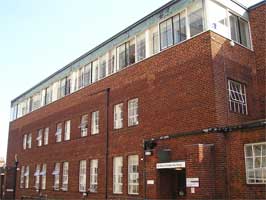 In 1941 Eric Zepler became a lecturer in the Department of Physics at Southampton University College. That department was located in the redbrick building now called the David Kiddle Building.
In 1941 Eric Zepler became a lecturer in the Department of Physics at Southampton University College. That department was located in the redbrick building now called the David Kiddle Building.
There were seven academic staff in the department, led by Prof A M Taylor, the Acting Head.
Eric Zepler was able to complete the first edition of his book on The technique of radio design, and arrange for it to be published by Chapman and Hall in 1943.
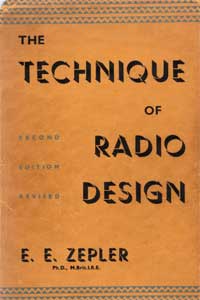 Copies of the first edition and the second edition (published in 1945) are available in the Hartley Library. The contents of both editions of this classic book are summarised on another webpage.
Copies of the first edition and the second edition (published in 1945) are available in the Hartley Library. The contents of both editions of this classic book are summarised on another webpage.
The preface to the first edition included the following tribute: A particular debt of gratitude is owed to Professor A M Taylor for his interest, encouragement and help during the past eighteen months that the author has been working in his department.
Mr S W Punnett was thanked in the preface for helping with proof reading. Wally Punnett was destined to be a close colleague of Eric Zepler throughout his time as Head of the new Department of Electronics, and to carry responsibility for many administrative activities.
1943-45 Classic book on radio design
Eric Zepler’s classic book The Technique of Radio Design was publised in two editions, in 1943 and 1945.
The relevant circuit theory was covered in the first chapter, and the rest of the book was devoted to the design of radios for industrial production. The operation and importance of negative feedback were explained in the third chapter. Later on there were thorough expositions of the problems of noise and distortion, and of undesired feedback in all its manifestations. The chapter on the principles of screening was a masterpiece.
This book was unique when it was published, because no books yet existed that covered the same material. Consequently there was no bibliography.
If you read this book you will appreciate Eric Zepler’s exceptional engineering ability. There was no guesswork. Every part of the design of a radio was based on the laws of physics, and was quantified and calculated. When Greville read the book he remember Zepler explaining at a blackboard how radio circuits should be designed.
1943-46 Cambridge University
From 1943 to 1946 Eric Zepler was seconded from Southampton University College to the Department of Physics at Cambridge University, as a lecturer. One of his duties was to teach the radio part of a degree course in “Physics with Radio”. Many of the students were Air Force officers. He gave them regular lectures from 5.00 to 6.00 pm in the Old Cavendish Green Lecture Theatre.
On one occasion the timing had to be altered, and the lecture was scheduled to run from 5.15 to 6.15 pm. During the lecture Eric Zepler unfortunately forgot the new finishing time, and he ended his talk at 6.00 pm. When he pulled down the blackboard at the start of the next lecture he found that the following limerick had been written on it by one of the students.
"A certain man, Zepler by name,
Was known far and wide for his fame.
One day, in a fix,
He finished at six,
So I won’t get a First – what a shame."
When the students arrived for the next lecture they found the following limerick on the blackboard.
I deeply deplore your disaster,
But to avoid it becoming still vaster,
And to prevent all future reproaching,
I suggest some additional coaching,
Which will make you a Master the faster.
Limericks provided by Carole Zepler.
1947-49 Southampton Electronics Department
In October 1946 Eric Zepler returned to the Department of Physics at Southampton University College, with the title of Lecturer in Telecommunications. Prof A M Taylor was now Head of Department, and there were 5 other Lecturers (including Wally Punnett) and two Assistant Lecturers.
Eric Zepler had become a Member of the British Institution of Radio Engineers (M Brit IRE). This Institution brought together professional engineers who worked in the relatively new discipline of radio engineering. Members of the older Institution of Electrical Engineers were mostly engaged in electrical power engineering.
Eric Zepler and Wally Punnett planned, and prepared for, the launch of a new postgraduate course leading to a Diploma in Electronics, Telecommunications and Radio Engineering in the Faculty of Science. That course started in October 1947, with five students. At the same time, the new Department of Electronics, Telecommunications and Radio Engineering was launched, with Zepler and Punnett being the only academic staff. Eric Zepler was promoted to Senior Lecturer in 1948 and to a Chair of Electronics in 1949. Also in 1949 the titles of the Department and of the diploma course were shortened to Electronics.
The postgraduate diploma course, which lasted for 3 terms, was like an MSc course nowadays. It soon became well-known nationally and internationally, and it attracted many able graduates having degrees in physics, engineering and related subjects.
In 1952 the University College in Southampton, which had previously prepared students for degrees awarded by London University, became an independent university. From then on, new students were registered for degrees and diplomas of the University of Southampton.
1950-59 New Staff and New Courses
In 1950 Mr T B Tomlinson was appointed as a Lecturer in the Department of Electronics, and in 1952 Dr D J E Ingram joined the department as a Research Fellow and Lecturer. David Ingram’s research involved paramagnetic and electron spin resonance spectroscopies.
In 1952 a new 3-year BSc (Eng) course in Electronic Engineering was launched in the Faculty of Engineering. Most of that course was common with the existing course in Electrical Engineering, within the broad engineering curriculum offered by that faculty. Within such a broad course the teaching of electronics was necessarily limited in scope. Up to 1959 only 2 or 3 students graduated from that course each year.
Dr M E Spinks and Mr B H Venning were appointed as Lecturers in 1954 and 1955 respectively. In October 1957 Dr Spinks and Mr Tomlinson had gone, David Ingram became a Reader, and Dr W A Gambling was appointed as a Lecturer. In that month Greville Bloodworth embarked on the Postgraduate Diploma in Electronics course.
In October 1959 David Ingram moved to a Chair at the University of Keele, and Greville Bloodworth was appointed as a Lecturer to replace him. Dr E V Vernon, a physicist, was also appointed as a Lecturer at the same time. Dr H Stachera was appointed a year later.
The development of solid-state electronics during the 1950’s and 1960’s offered attractive careers for graduates. Therefore it was clear that undergraduate courses concentrating on electronics were needed, to enable students to study this challenging subject in more breadth and depth. Our department was the first one in Britain to respond to this need, by launching a new BSc course in Electronics in October 1959, in the Faculty of Science. In that year the first silicon integrated circuits were being developed in industrial research laboratories. By 1970 microprocessors would be made as integrated circuits that each comprised over 1000 silicon transistors.
1951 International Master of Chess Composition
<p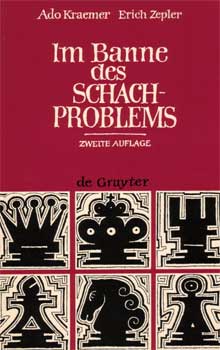 >When he started to compose chess problems at the age of 14 Erich Zepler was destined to become one of the leaders of the new German school of chess problem composition (also known as the logical school). He mainly composed direct mates with three or more moves. In the 1920’s he started to work on chess problems with Ado Kraemer, another German also born in 1898. This collaboration continued when the Nazis came to power, even though Kraemer became a member of the brown-shirted SA and Zepler had been born a Jew. It was interrupted in 1935 when Zepler moved to England.
>When he started to compose chess problems at the age of 14 Erich Zepler was destined to become one of the leaders of the new German school of chess problem composition (also known as the logical school). He mainly composed direct mates with three or more moves. In the 1920’s he started to work on chess problems with Ado Kraemer, another German also born in 1898. This collaboration continued when the Nazis came to power, even though Kraemer became a member of the brown-shirted SA and Zepler had been born a Jew. It was interrupted in 1935 when Zepler moved to England.
After the Second World War Zepler helped Kraemer to be released from internment by the Allies, and they were then able to resume their work together on chess problems. In 1951 they published some of their best work in the book Im Banne des Schachproblems (Under the Spell of Chess Problems). A revised version of this book was published in 1971. They also published in 1957 their selection of the best chess problems devised by others, in Problemkunst im 20. Jahrhundert (The art of the chess problem in the 20th century).
Eric Zepler played chess for the Hampshire county team. In 1957 he became an International Judge of Chess Competitions, and in 1973 he became an International Master of Chess Composition. He once said that the latter title gave him more pleasure than the honorary Doctor of Science in Engineering degree that he was awarded by Southampton University in 1977.
Besides chess Eric Zepler had many other interests, including literature, music and art. He also enjoyed playing bridge, which he had learned when he was interned in 1940.
1959-60 President of the Brit IRE
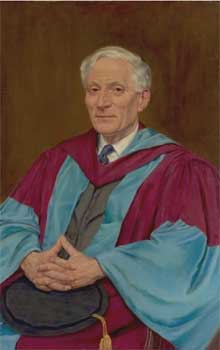 Eric Zepler was the President of the British Institution of Radio Engineers in 1959 and 1960. As a new member of his department in 1959 Greville Bloodworth naturally joined the same institution. Eric Zepler was succeeded as President of the Brit IRE in 1961 and 1962 by the Earl Mountbatten of Burma, who had a longstanding interest in radio engineering. He is best known for his command of the allied forces in Burma during the Second World War and for being the last Viceroy of India. He lived near Romsey.
Eric Zepler was the President of the British Institution of Radio Engineers in 1959 and 1960. As a new member of his department in 1959 Greville Bloodworth naturally joined the same institution. Eric Zepler was succeeded as President of the Brit IRE in 1961 and 1962 by the Earl Mountbatten of Burma, who had a longstanding interest in radio engineering. He is best known for his command of the allied forces in Burma during the Second World War and for being the last Viceroy of India. He lived near Romsey.
The School of Electronics and Computer Science is based in two adjoining buildings named after Zepler and Mountbatten. The Zepler Building was opened in 1999. The original Mountbatten Building was destroyed by fire in 2005, and it has been replaced by a new building with the same name that was officially opened in January 2011. It houses the Zepler Institute, which was founded in his name in 2013.
Sources of Information
Since I did not meet Eric Zepler until he was 59 years old, in writing about his earlier life and work I have relied on information from publications and from his family. Most of that information has come from the following people.
Firstly I must express most sincerely my gratitude to Carole Zepler and Matthew Zepler for all of the help that they have given to me, when I was writing about their father for the Oxford Dictionary of National Biography, and now that I have written in more detail in these webpages. This time there is room not only for more words, but also for photographs of their father in his younger days that have not been published before.
Secondly I must acknowledge the use that I have made of the biography of Eric Zepler written by Professor Berthold Bosch of Ruhr University at Bochum, entitled ‘Dr Erich Zepler: ein wechselvolles Leben fur die Funktechnik’ (an eventful life in radio engineering), that was published in Funkgeschichte no. 72 (1990) pp 9-15. Carole and Matthew have translated that publication from German to English. Also I have used information from other publications and from websites.
In 1956 Berthold Bosch came from Germany to our Department of Electronics to undertake research for a PhD degree, supervised by Eric Zepler. His thesis on ‘Noise in Microwave Oscillators’ was submitted successfully in 1960, when I was working in the department as a lecturer.
In 1980, after the death of Eric Zepler, Berthold Bosch arranged for the transfer to the Department of Electronics, from Bochum, of a Telefunken T9W radio receiver, on permanent loan from AEG/Telefunken. That historic receiver, which was designed in 1927-8 by Eric Zepler and Ernst Klotz, is described in some of these webpages. I have used information about it that was provided by David Dawkins, when he maintained it in working order in the School of Electronics and Computer Science.